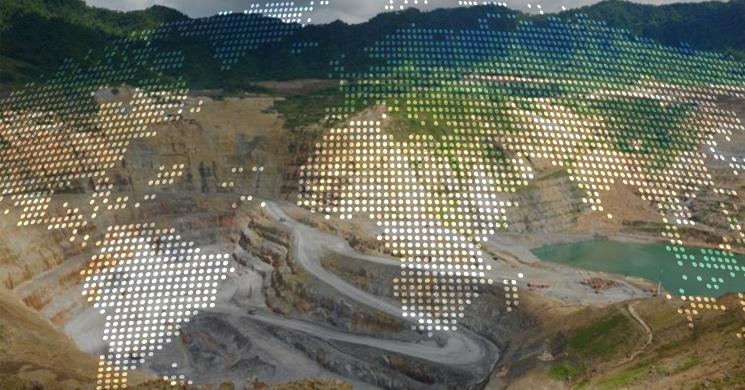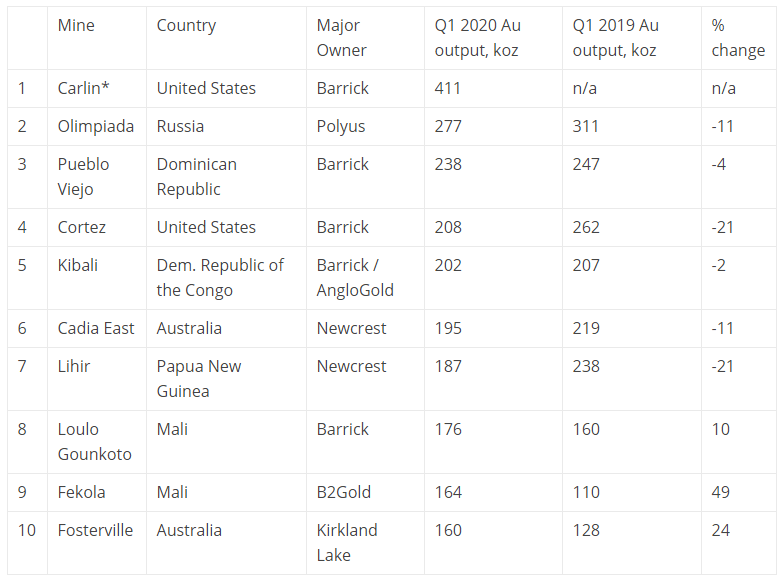
Global gold production fell by 4% during Q1 2020. Carlin operation in the United States was the world’s largest gold mine by production in Q1 2020.
Over the past months, Mines and Metals created a series of stories covering gold mining industry and largest gold mining operations performance in different regions during Q1 2020, with the focus on gold output, production costs and gold grades. These stories can be found here.
Now it is a good time to look at the holistic picture of the state of the gold mining industry in Q1 2020 and review the performance of the most remarkable mines worldwide.
Based on quarterly reported corporate data, the world’s gold mining sector produced 14.28 Moz of gold in Q1 2020, which was 4% less than a year before (14.82 Moz).
With 3.8 Moz of gold mined during Q1 2020, North America was the largest gold producing region worldwide, followed by Africa (3.3 Moz) and Australia & Oceania (2.2 Moz).
Africa increased gold production by 2% to 3.3 Moz and kept chasing North America which lost 8% in gold output during Q1 2020 (Figure 1).

Figure 1. Global gold output in Q1 2020 vs. Q1 2019. Source: Mines and Metals.
Below is an overview of the top 10 largest gold mines in the world developed by Mines and Metals on the basis of Q1 2020 reported production figures; hence, the world’s leading Muruntau gold mine in Uzbekistan was excluded from this quarterly ranking due to lack of reported numbers.
Barrick’s Carlin complex in Nevada was the largest gold mining operation in the world during Q1 2020, with gold output amounted to 411 koz.
With 277 koz of gold mined in Q1 2020, Polyus’ gigantic Olimpiada operation was the largest gold producing center in Russia and second largest worldwide. Total gold output (refined and concentrate) of 277 koz declined by 11% compared to Q1 2019 (311 koz), due to changes in gold in inventory at the refinery.
Barrick’s Pueblo Viejo mine in the Dominican Republic is third largest gold operation worldwide with 238 koz mined during Q1 2020.
Another Barrick’s Cortez operation is fourth with 208 koz of gold produced in Q1 2020, a 21% decline over Q1 2019 (262 koz).
With 202 koz produced in Q1 2020, Barrick / AngloGold’s Kibali mine in DRC was the largest gold mine in Africa and fifth biggest operation worldwide.
With 195 koz of gold mined in March Quarter 2020, Newcrest’s Cadia East mine was the largest gold producing center in Australia and sixth biggest operation in the world.
Another Newcrest’s Lihir mine in Papua New Guinea sits seventh with 187 koz produced in Q1 2020.
Barrick’s Loulo Gounkoto mine in Mali is eighth with 10% improvement in output y-o-y.
B2Gold’s Fekola mine in Mali boasted a 49% increase in gold output and jumped several positions up in the ranking. With 164 koz produced in Q1 2020, Fekola is ninth largest gold mine in the world.
Kirkland Lake’s Fosterville mine in Australia closing the top 10 list with 160 koz of gold mined in Q1 2020, a 24% increase y-o-y.
Here’s the Q1 2020 ranking developed by Mines and Metals.

* Barrick’s Goldstrike (including Barrick’s 60% share of South Arturo) and Newmont’s Carlin were contributed to Nevada Gold Mines and are now referred to as Carlin. No comparable data available for Q1 2019.
1. Carlin, USA. 411 koz.

Carlin gold mine. Source: Newmont
On July 1, 2019, Barrick’s Goldstrike (including 60% share of South Arturo) and Newmont’s Carlin were contributed to Nevada Gold Mines and are now referred to as Carlin. This gigantic integrated operation located west of the city of Elko on the geologic feature known as the Carlin Trend. Stretching 56km (35mi), the Carlin Trend was first prospected by Newmont geologists John Livermore and Alan Coope in 1965.
2. Olimpiada. 277 koz.

Located in one of Russia’s most prolific gold mining provinces, Olimpiada is largest gold mine in Russia, one of the largest gold mines on the globe, and Polyus’ largest operation. The mine began production in 1996 and currently accounts for over a half the Moscow-based company’s total gold output. The ore mined at the site is processed at three plants with a combined capacity of 13 million tonnes of ore annually. To treat Olimpiada’s sulphide ores, Polyus employs BIONORD, the Company’s proprietary bio-oxidation technology.
3. Pueblo Viejo, Dominican Republic. 238 koz.

Pueblo Viejo gold mine. Source: Barrick
The Pueblo Viejo mine in the Dominican Republic is about 100 km northwest of the capital city of Santo Domingo. The mine is operated by the Pueblo Viejo Dominicana Corporation — a joint venture between Barrick (60%) and Newmont (40%).
4. Cortez, USA. 208 koz.

Cortez mine. Source: Barrick
Cortez Gold Mine is a large gold mining and processing facility in Lander and Eureka County, Nevada, United States, located approximately 75 miles (120 km) southwest of Elko and comprises the Pipeline and South Pipeline deposits and the Cortez Hills deposit. Pipeline and South Pipeline are open pit mines, while Cortez Hills is an underground and open pit mining operation. On July 1, 2019, Cortez was contributed to Nevada Gold Mines, a joint venture between Barrick and Newmont Corporation.
5. Kibali, DRC. 202 Koz.

Kibali gold mine. Source: Barrick.
The Kibali gold mine is located in the northeast of the Democratic Republic of Congo (DRC), approximately 220 kilometres east of the capital of the Haut Uele province, Isiro, 150 kilometres west of the Ugandan border town of Arua and 1,800 kilometres from the Kenyan port of Mombasa. The mine is owned by Kibali Goldmines SA (Kibali) which is a joint venture company effectively owned 45% by each of Barrick and AngloGold Ashanti, and 10% by Société Miniére de Kilo-Moto (SOKIMO). The mine is operated by Barrick.
6. Cadia East, Australia. 195 koz.

Cadia East mine. Source: Newcrest.
Newcrest’s Cadia is made up of the Cadia East underground panel cave mine and the Ridgeway underground mine (currently in care and maintenance). Cadia East is the biggest gold mine in Australia despite 11% production decline in March Quarter 2020.
7. Lihir, PNG. 187 koz.

Lihir gold mine. Source: Newcrest
Newcrest’s Lihir operation on Aniolam Island in the New Ireland Province of Papua New Guinea is 900 kilometres north-east of the capital Port Moresby. The gold deposit at Lihir is within the Luise Caldera, an extinct volcanic crater that is geothermally active.
8. Loulo-Gounkoto, Mali. 176 koz.

Loulo mine. Source: Barrick.
Barrick’s Loulo-Gounkoto complex comprises two distinct mining permits, Loulo and Gounkoto, and is situated in western Mali, bordering Senegal and adjacent to the Falémé River. Société des Mines de Loulo SA (Loulo) owns the Loulo gold mine, and Société des Mines de Gounkoto (Gounkoto) owns the Gounkoto gold mine. Both Loulo and Gounkoto are owned by Barrick (80%), and the State of Mali (20%).
9. Fekola, Mali. 164 koz.

Fekola mine. Source: B2Gold
The Fekola Mine is located in southwest Mali, on the border between Mali and Senegal, approximately 500 km due west of the capital city, Bamako. B2Gold acquired the world-class Fekola Gold Project through a merger with Papillon Resources Limited in October 2014. The first gold pour at the Fekola Mine took place on October 7, 2017. Within only 60 days from start-up, the mine achieved commercial production on November 30, 2017, one month ahead of the revised schedule and four months ahead of the original schedule.
10. Fosterville, Australia. 160 koz.

Fosterville mine. Source: Kirkland Lake.
Kirkland Lake’s Fosterville Mine is second highest-grade and one of the lowest-cost gold mine globally, located 20km from the city of Bendigo in the State of Victoria, Australia. The Fosterville Mine features growing gold production at increasingly high grades, as well as extensive in-mine and district scale exploration potential. In March Quarter 2020, Kirkland Lake achieved 25% y-o-y production growth at Fosterville.
Read more by Vladimir Basov







